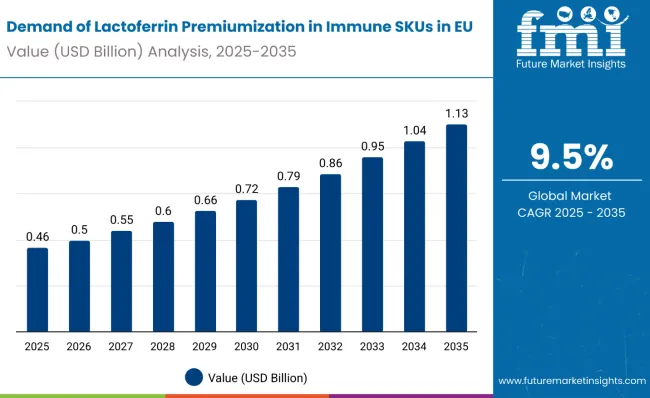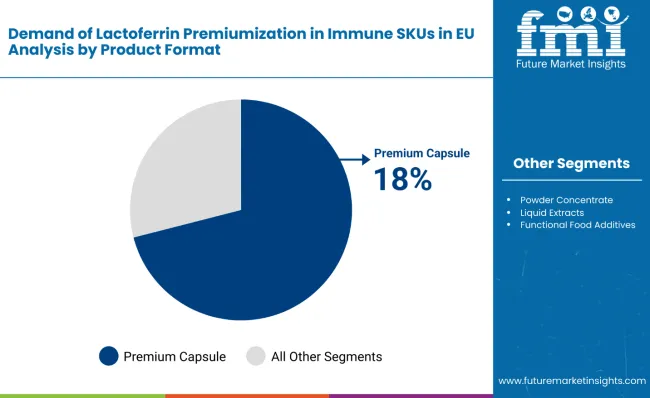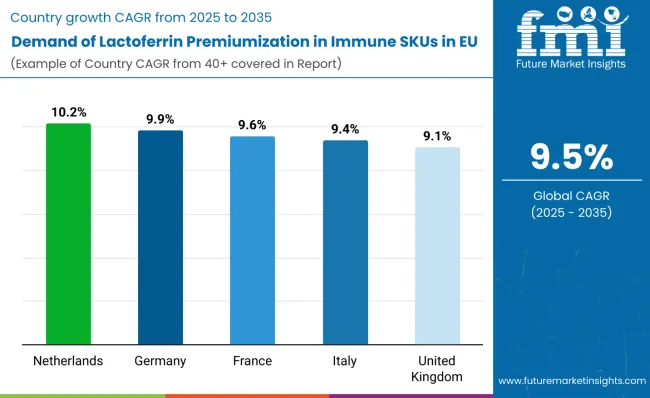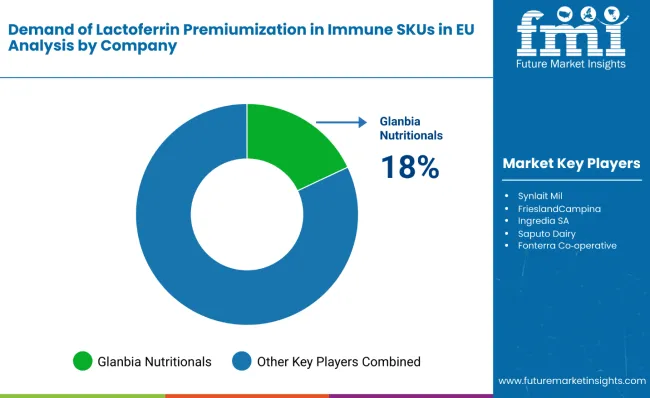Sales of lactoferrin-enhanced immune products in the European Union are estimated at USD 0.46 billion in 2025, with projections indicating a rise to USD 1.13 billion by 2035, reflecting a CAGR of approximately 9.5% over the forecast period. This growth reflects both expanding consumer awareness of bioactive proteins and increased per capita spending on premium immune support formulations in key European cities.

The rise in demand is linked to aging demographics, growing focus on preventive health, and evolving premium wellness trends. By 2025, per capita consumption in leading EU countries such as Germany, France, and Netherlands averages between 0.8 to 1.1 kilograms, with projections reaching 1.4 kilograms by 2035. London leads among metropolitan areas, expected to generate USD 203 million in lactoferrin immune product sales by 2035, followed by Berlin (USD 103 million), Paris (USD 85 million), Amsterdam (USD 70 million), and Munich (USD 56 million).
The largest contribution to demand continues to come from premium capsule formulations, which are expected to account for 71% of total sales in 2025, owing to superior bioavailability, extended shelf stability, and practitioner endorsement. By distribution channel, specialty health stores represent the dominant retail format, responsible for 58% of all sales, while online wellness platforms and pharmacy chains are expanding rapidly.
Consumer adoption is particularly concentrated among health-conscious professionals and wellness-focused millennials, with income and urban density emerging as significant drivers of demand. While price remains a consideration, the average premium over conventional immune supplements has stabilized at 340% in 2025, down from 380% in 2020.
Continued improvements in extraction technology and formulation efficiency are expected to accelerate accessibility across upper-middle-income households. Regional disparities persist, but per capita demand in Central European cities is narrowing the gap with traditionally strong Northern European wellness hubs.
The lactoferrin immune products segment in the EU is classified across several dimensions. By product format, the key categories include premium capsules, powder concentrates, liquid extracts, and functional food additives. By distribution channel, the segment spans specialty health stores, online wellness platforms, pharmacy chains, premium grocery retailers, and practitioner clinics. By source type, formulations include bovine lactoferrin, human-identical lactoferrin, camel-derived variants, and synthetic bioidentical compounds.
By consumer profile, the segment covers health-conscious professionals, wellness-focused millennials, aging baby boomers, competitive athletes, and individuals with compromised immunity. By region, countries such as Germany, France, Netherlands, United Kingdom, and Italy are included, along with coverage across all 27 EU member states plus the UK. By city, key metro areas analyzed include London, Berlin, Paris, Amsterdam, and Munich.

Premium capsules are projected to dominate sales in 2025, supported by superior absorption profiles, convenient dosing protocols, and healthcare professional recommendations. Other formats such as powders, liquids, and functional additives are growing steadily, each serving distinct consumption preferences.

Lactoferrin immune products in the EU are distributed through a mix of specialized wellness retail and mainstream health channels. Specialty health stores are expected to remain the primary point of sale in 2025, followed by online wellness platforms and pharmacy chains. Distribution strategies are evolving to match consumer shopping behavior, with growth coming from both expert-guided and digital self-service formats.
Lactoferrin immune products in the EU utilize various protein sources, selected for efficacy, cost efficiency, allergen considerations, and bioavailability profiles. Bovine lactoferrin remains the most widely used protein input, though human-identical and alternative sources are gaining momentum. Product developers are increasingly exploring novel extraction methods and hybrid formulations to meet evolving consumer and regulatory demands.
The lactoferrin immune products category appeals to a diverse consumer base across age groups, income levels, and health motivations. While drivers vary from preventive wellness to therapeutic support to performance enhancement, demand is concentrated among five key demographic clusters. Each group brings distinct purchase behaviors, channel preferences, and product expectations.

Lactoferrin immune product sales will not grow uniformly across every metropolitan area. Rising health awareness and faster per-capita adoption in Central European cities give Munich and Amsterdam a measurable edge, while mature Northern European hubs such as London expand more steadily from a higher base. The table below shows the compound annual growth rate (CAGR) each of the five largest cities is expected to record between 2025 and 2035.
Between 2025 and 2035, demand for lactoferrin immune products is projected to expand across all major European metropolitan areas, but the pace of growth will vary based on demographic shifts, wellness penetration, and baseline consumption levels. Among the top five cities analyzed, Munich and Amsterdam are expected to register the fastest compound annual growth rate (CAGR) of 2.87%, outpacing more established wellness hubs.
This acceleration is underpinned by a combination of factors: growing health consciousness, increasing disposable income allocation to wellness, and expanding availability of premium immune formulations across specialty retailers and online platforms. In both cities, per capita consumption is projected to rise from 0.9 kg in 2025 to 1.2 kg by 2035, closing the gap with higher-consumption cities such as London and Berlin. Retail assortment is also expanding faster in these regions, with new therapeutic-grade and practitioner-recommended formats gaining traction in wellness centers and premium pharmacies.
Berlin and Paris are each forecast to grow at a CAGR of 2.71% over the same period. Both cities already maintain established wellness ecosystems, with widespread access to premium lactoferrin formulations in specialty stores, pharmacies, and online platforms.
In Berlin, growth is supported by a strong preventive health culture, clinical innovation, and increasing uptake of bioactive immune supplements. Paris reflects similar dynamics, particularly among wellness-conscious professionals and households seeking evidence-based immune optimization. In both cities, per capita consumption is projected to increase from 1.0 kg in 2025 to 1.3 kg by 2035, reflecting mainstreaming of premium immune supplementation.
London, while maintaining the highest overall sales in absolute terms, is expected to grow at a CAGR of 2.54%, slightly below its Continental counterparts. The city already exhibits higher-than-average per capita intake (1.1 kg in 2025), extensive product saturation, and a dense wellness retail network. Growth will likely come from repeat purchasing, new therapeutic applications, and premium formulation expansion rather than first-time trial.
Collectively, these five metro areas represent the core of urban demand for lactoferrin immune products in the EU, but their individual growth paths highlight the importance of regional tailoring in pricing, formulation development, and channel strategy.

The competitive environment is characterized by a mix of established dairy ingredient suppliers and specialized bioactive protein manufacturers. Distribution breadth rather than sheer product variety remains the decisive success factor: the five largest suppliers collectively reach more than 15,000 specialty retail outlets across the EU and account for a majority of premium shelf facings in the category.
Glanbia Nutritionals is the most established participant. Leveraging its dairy heritage, the company offers more than 40 lactoferrin-based formulations, all backed by clinical research and regulatory compliance. Its core range of premium capsules and concentrates gives it deep penetration in specialty health channels while maintaining full European coverage through wellness retailers and online platforms.
Synlait Milk, through its European distribution partnerships, leverages advanced extraction technology to place high-purity lactoferrin ingredients in premium immune formulations across specialty stores and pharmacy chains. Post-expansion investments in bioprocessing have allowed Synlait to introduce therapeutic-grade concentrations priced at premium levels, reinforcing its role as a key supplier for European supplement manufacturers.
FrieslandCampina benefits from integrated dairy operations and established European distribution networks within a USD 12 billion dairy portfolio and from co-processing with other nutritional ingredient lines. Recent launches under the biotechnology division extend Friesl and Campina beyond traditional ingredients into finished immune products targeting the premium wellness consumer.
The next tier comprises specialized ingredient companies and emerging biotechnology firms. Saputo Dairy focuses on application-specific lactoferrin formulations and clinical-grade concentrates; recent regulatory filings showed quarterly ingredient sales of USD 30 million, signaling European but still specialized scale. Ingredia SA, now expanding through strategic partnerships, adds fermentation-derived lactoferrin to the European supply chain and is expected to benefit from technological advancement and sustainable production methods.
Private-label programs at Holland & Barrett, Boots, and premium pharmacy chains are widening assortment at price points 20-25% below branded equivalents, putting margin pressure on smaller suppliers while supporting category entry. Consolidation is therefore likely to continue as extraction scale and omnichannel reach become critical for maintaining shelf visibility and clinical credibility in this rapidly evolving category.
| Attribute | Details |
|---|---|
| Study Coverage | EU sales and consumption of lactoferrin -enhanced immune products from 2020 to 2035 |
| Base Year | 2025 |
| Historical Data | 2020 |
| Forecast Period | 2025-2035 |
| Units of Measurement | USD (sales), Metric Tonnes (volume), Kilograms per capita (consumption) |
| Geography Covered | All 27 EU member states + UK; country-level and city-level granularity |
| Top Countries Analyzed | Germany, France, Netherlands, United Kingdom, Italy, 30+ |
| Top Cities Analyzed | London, Berlin, Paris, Amsterdam, Munich and 40+ |
| By Product Format | Premium capsules, Powder concentrates, Liquid extracts, Functional additives |
| By Distribution Channel | Specialty health stores, Online wellness platforms, Pharmacy chains, Premium grocery, Practitioner clinics |
| By Source Type | Bovine, Human-identical, Camel-derived, Synthetic bioidentical, Novel extraction |
| By Consumer Profile | Health-conscious professionals, Wellness millennials, Aging boomers, Athletes, Immune-compromised |
| Metrics Provided | Sales (USD), Volume (MT), Per capita consumption (kg), CAGR (2025-2035), Share by segment |
| Price Analysis | Average unit prices by product format and region |
| Competitive Landscape | Company profiles, private label strategies, clinical validation, European vs. global |
| Forecast Drivers | Per capita demand trends, wellness penetration, price optimization, demographic shifts |
By 2035, total EU sales of lactoferrin immune products are projected to reach USD 1.13 billion, up from USD 0.46 billion in 2025, reflecting a CAGR of approximately 9.5%.
Premium capsules hold the leading share, accounting for approximately 71% of total sales in 2025, followed by powder concentrates and liquid extracts.
Munich and Amsterdam lead in projected growth, each registering a CAGR of 2.87% between 2025 and 2035, due to rising health consciousness and expanding wellness retail penetration.
Specialty health stores are the dominant sales channel (58% share in 2025), but online wellness platforms and pharmacy chains are growing at double-digit CAGR, especially in urban regions.
Major players include Glanbia Nutritionals, Synlait Milk, FrieslandCampina, Saputo Dairy, and Ingredia SA, with growing competition from private label brands like Holland & Barrett and Boots wellness lines.






Our Research Products

The "Full Research Suite" delivers actionable market intel, deep dives on markets or technologies, so clients act faster, cut risk, and unlock growth.

The Leaderboard benchmarks and ranks top vendors, classifying them as Established Leaders, Leading Challengers, or Disruptors & Challengers.

Locates where complements amplify value and substitutes erode it, forecasting net impact by horizon

We deliver granular, decision-grade intel: market sizing, 5-year forecasts, pricing, adoption, usage, revenue, and operational KPIs—plus competitor tracking, regulation, and value chains—across 60 countries broadly.

Spot the shifts before they hit your P&L. We track inflection points, adoption curves, pricing moves, and ecosystem plays to show where demand is heading, why it is changing, and what to do next across high-growth markets and disruptive tech

Real-time reads of user behavior. We track shifting priorities, perceptions of today’s and next-gen services, and provider experience, then pace how fast tech moves from trial to adoption, blending buyer, consumer, and channel inputs with social signals (#WhySwitch, #UX).

Partner with our analyst team to build a custom report designed around your business priorities. From analysing market trends to assessing competitors or crafting bespoke datasets, we tailor insights to your needs.
Supplier Intelligence
Discovery & Profiling
Capacity & Footprint
Performance & Risk
Compliance & Governance
Commercial Readiness
Who Supplies Whom
Scorecards & Shortlists
Playbooks & Docs
Category Intelligence
Definition & Scope
Demand & Use Cases
Cost Drivers
Market Structure
Supply Chain Map
Trade & Policy
Operating Norms
Deliverables
Buyer Intelligence
Account Basics
Spend & Scope
Procurement Model
Vendor Requirements
Terms & Policies
Entry Strategy
Pain Points & Triggers
Outputs
Pricing Analysis
Benchmarks
Trends
Should-Cost
Indexation
Landed Cost
Commercial Terms
Deliverables
Brand Analysis
Positioning & Value Prop
Share & Presence
Customer Evidence
Go-to-Market
Digital & Reputation
Compliance & Trust
KPIs & Gaps
Outputs
Full Research Suite comprises of:
Market outlook & trends analysis
Interviews & case studies
Strategic recommendations
Vendor profiles & capabilities analysis
5-year forecasts
8 regions and 60+ country-level data splits
Market segment data splits
12 months of continuous data updates
DELIVERED AS:
PDF EXCEL ONLINE
Demand Signal Repository Solutions Market Size and Share Forecast Outlook 2025 to 2035
Demand Side Management Market Size and Share Forecast Outlook 2025 to 2035
Demand Response Market Analysis - Size, Share, and Forecast Outlook 2025 to 2035
North America Shipping Supplies Market Trends – Innovations & Growth 2024-2034
Demand of Kozani Saffron in Greece Analysis - Size, Share & Forecast 2025 to 2035
Demand of No-acid Whey Strained Dairy Processing Concepts in European Union Size and Share Forecast Outlook 2025 to 2035
Demand for Bronte Pistachio in Italy Analysis - Size, Share & Forecast 2025 to 2035
Demand and Trend Analysis of Gaming Monitor in Japan Size and Share Forecast Outlook 2025 to 2035
Demand and Trend Analysis of Gaming Monitor in Korea Size and Share Forecast Outlook 2025 to 2035
Demand and Trend Analysis of Gaming Monitor in Western Europe Size and Share Forecast Outlook 2025 to 2035
Glycine Soja (Soybean) Seed Extract Market Size and Share Forecast Outlook 2025 to 2035
Demand and Trend Analysis of Yeast in Japan - Size, Share, and Forecast Outlook 2025 to 2035
Demand and Trends Analysis of Stevia in Japan Size and Share Forecast Outlook 2025 to 2035
Demand of Pistachio-based desserts & ingredients in France Analysis - Size, Share & Forecast 2025 to 2035
Japan Women’s Intimate Care Market Trends – Growth & Forecast 2024-2034
Western Europe Men’s Skincare Market Analysis – Forecast 2023-2033
Demand and Trend Analysis of Fabric Stain Remover in Korea Size and Share Forecast Outlook 2025 to 2035
Demand and Sales Analysis of Paper Cup in Japan Size and Share Forecast Outlook 2025 to 2035
Demand and Sales Analysis of Paper Cup in Korea Size and Share Forecast Outlook 2025 to 2035
Demand of MFGM-enriched Powders & RTDs in European Union Size and Share Forecast Outlook 2025 to 2035

Thank you!
You will receive an email from our Business Development Manager. Please be sure to check your SPAM/JUNK folder too.
Chat With
MaRIA